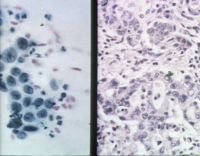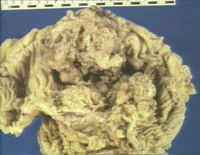Adenocarcinoma
Gastric Adenocarcinoma
Adenocarcinoma is the most common gastric neoplasm in small animals. It is a tumour of the mucosal epithelium. These are generally found in the fundus (particularly along the lesser curvature), and in the pylorus. There are two main internal appearances of gastric adenocarcinoma, both of which show thickened, oedematous, pale and firm tissue:
- A diffuse infiltration of gastric mucosa by neoplastic glandular epithelial cells.
- Causes a diffuse rugal thickening.
- A more solitary lesion that is seen as a thick plaque-like lesion
- Generally has a central erosion/ulceration of the tumour tissue.
- Distinguishable from a peptic ulcer as the edges of the eroded area are raised and thickened (tumour tissue).
The external appearance of an affected stomach can include thickening of the draining lymphoid vessels due to tumour infiltration ('cording of the lymphatics') and evidence of a scirrhous reaction to the carcinoma. Adenocarcinomas are locally aggressive and spread via the lymphatics to the lymph nodes, lung, liver and adrenal glands.
Intestinal Adenocarcinoma
Intestinal adenocarcinomas are a reasonably common malignant neoplasm of dogs and cats arising from the epithelial lining of the gastrointestinal tract. As yet, no causative organism or chemical agent has been identified for intestinal adenocarcinomas, but experiments have suggested that nitrosamines may have a role. Intestinal adenocarcinomas can be nodular or annular in appearance. By the time of diagnosis, they have often metastasised via the lymphatic and vascular routes, most commonly to the mesenteric lymph nodes. Other sites of metastasis include the liver, kidneys, peritoneal cavity, omentum and lungs. Intestinal adenocarcinomas display aggressive local growth and invasion, and tumours frequently recur after resection.
Perianal Gland Adenocarcinoma
These tumours are far less commonly diagnosed than perianal adenomas. Large breed male dogs are overrepresented, but they do also occur in spayed female dogs.
A hormonal dependence has not been shown.
Clinical features
Tumours are usually single, ulcerated and invasive. They tend to grow rapidly, and to a larger size than the benign version.
30% of adenocarcinomas metastasize to the sublumbar lymph nodes, liver and lungs.
Diagnosis
Cytology will reveal large hepatoid cells with a large nucleus, prominent nucleoli and a large cytoplasm. It will not distinguish between adenomas and adenocarcinomas.
Further investigation should be carried out if malignancy is suspected, including: thoracic and abdominal radiography, abdominal ultrasound, and cytology or biopsy of enlarged lymph nodes.
Treatment
Adenocarcinomas do not regress following castration. Small tumours can be treated by wide surgical excision, with or without cryosurgery.
For large masses, surgical debulking followed by radiotherapy may be useful.
Dogs with metastasis have a poor prognosis, but may be treated by surgical excision and intravenous doxorubicin for a slightly prolonged survival time.
Adenocarcinomas of the Glands of the Anal Sac (Apocrine Glands)
Apocrine glands are the true anal glands - not to be confused with the anal sacs or the perianal glands. These tumours are much less common than intestinal adenocarcinoma. They are more common in bitches than dogs and can be bilateral.
The masses may cause local problems and metastasise. They often secrete a parahormone-like substance to cause paraneoplastic syndrome. This can arise even when the primary tumour is very small resulting in bone resorption and hypercalcaemia, which in turn can cause renal failure.
Anal Sac Adenocarcinoma
Anal sac adenocarcinoma is a highly malignant neoplasia that readily metastasizes to the medial iliac lymph nodes. Around 50% may lead to paraneoplastic hypercalcaemia due to parathyroid hormone-related peptide (PTH-rP). The tumours can be between 1 and 10cm in size and 50% of them will metastasize
Nasal Cavity
Adenocarcinoma of the nasal cavity is most common in dogs but also sheep. Glandular acini in layer of cuboidal or columnar epithelium are present with often mucin filled acini.
Uterine Adenocarcinoma in Rabbits
References
Withrow, S. (2001) Small animal clinical oncology Elsevier Health Sciences
Morrison, W. (2002) Cancer in dogs and cats: medical and surgical management Teton NewMedia
| Adenocarcinoma Learning Resources | |
|---|---|
To reach the Vetstream content, please select |
Canis, Felis, Lapis or Equis |

